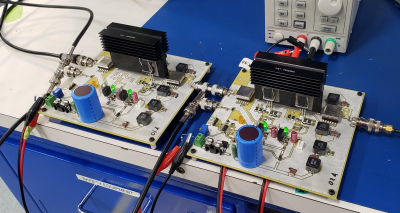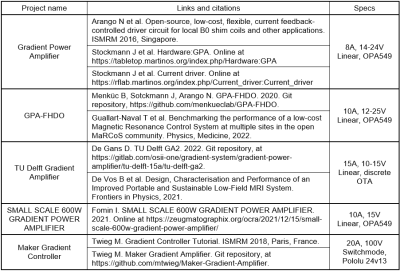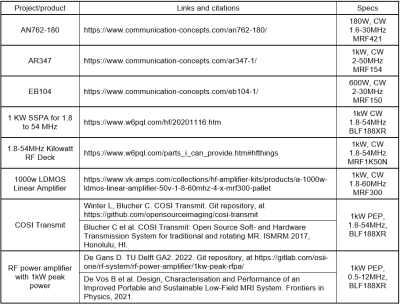The RF & Gradient Amplifiers
1Hyperfine Research, United States
Synopsis
Most low-field MRI projects make use of off-the-shelf gradient and RF power amplifiers, but such options are often poor fits for low-field applications, especially if cost is a concern. Thus there is increasing interest in designs aimed towards low-field systems. This talk covers existing designs and projects, and discusses some of the tradeoffs between them. A new open source RFPA design, The Easy RFPA, is also presented.
Hardware for low-field MRI
Recent years have seen increased interest in new low field MRI systems. Low field systems boast qualities such as low cost and easier siting, and thus may be more accessible to patients and caregivers. Realizing such advantages requires optimizing the system hardware for the low-field application. Here we will discuss two particular subsystems, the RF and gradient power amplifiers, and how low-field factors into their designs. We will also cover existing open source projects accessible to researchers developing their own low-field systems, and discuss one new open source design crafted for this session.Gradient power amplifiers for low-field systems
Gradient power amplifiers (GPAs) are one of the system components whose requirements do not directly depend on the B0 of the MRI scanner. A 3T scanner whose B0 is ramped down to 30mT will still have the same gradient requirements, all else being equal. For this reason, gradient systems are problematic for low field systems, especially those aimed towards low cost or low power applications.Gradient system requirements do, however, scale very strongly with maximum FOV of the system. Since most low field systems under development are not whole-body scanners, the power requirements from the GPAs can be drastically reduced. Foregoing diffusion-weighted imaging can further reduce power requirements, to the point where images can be had with just hundreds of watts of available power.
Table 1 lists several open-source gradient amplifier projects1-10 which may be applicable for low field applications. With the exception of the Maker Gradient Amplifier (which is more of an educational project than a practical design), all are implemented as linear amplifiers with relatively low power capacity. We will spend some time comparing the tradeoffs between linear and switchmode designs, and provide some guidance for potential switchmode amplifier designs.
RF power amplifiers for low-field systems
The RF power amplifier, or RFPA, drives the transmit RF coils in order to produce the B1+ magnetic field, which is responsible for exciting polarized spins (among many other roles in modern sequences).The RFPA is one MRI subsystem whose implementation gets significantly easier at lower field strength. The lower Larmor frequency f0 means that less power is lost due to sample conductivity, radiation, eddy currents, skin effect, etc. Thus, as f0 decreases less power is required from the RFPA to produce the same B1+ field.
The lower f0 also simplifies the design of the RFPA somewhat. For high field scanners, the RFPA is usually implemented with high performance LDMOS FETs, designed specifically for RF power amplification. However these require sophisticated construction and design techniques to leverage their potential, making them an intimidating prospect for researchers new to the field. They are also, of course, quite expensive.
For those who wish to develop RFPAs for low-field MRI applications, but lack the resources and experience to design with LDMOS FETs, there are a few options. One is to repurpose RFPA designs meant for other applications, such as amateur radio. Table 2 shows a list of select designs which might be adapted for low field MRI. Many of these are sold as kits, and their instructions give away some esoteric design techniques as a bonus.
One downside of designs from the amateur radio world is that they are typically intended for continuous wave (CW) operation, in which RFPA is always "on". For MRI applications, the RFPA typically only needs to be active with a very low duty cycle, usually under 2%. CW operation means that the power transistors must dissipate a great deal of power, and thus the RFPA requires substantial thermal management. This accounts for much of the cost of such RFPA designs. Unfortunately, if an MRI system requires a peak envelope power (PEP) of 1kW at a duty cycle of 5%, once cannot make use a 50W CW-rated RFPA. You must pay for the 1kW CW capacity, even if you only use 5% of it!
There are currently two open-source low-field RFPA designs7,11-13 which have emerged from the MRI community (if I have missed any, please let me know ASAP so I can add them). These are included at the bottom of Table 2. Both are designs resembling the HAM radio options, but add an unblanking feature. Unblanking (also referred to as blanking or gating) is when the bias voltage and/or current to the power transistors is enabled only when required by the pulse sequence. This drastically reduces the average power dissipated by the RFPA, and alleviates much of the thermal management challenge. Blanking/unblanking also reduces the noise generated by the RFPA when the receivers are recording NMR signals, which is also critical for low-field applications.
All of the designs mentioned up until now make use of the aforementioned LDMOS FETs for the final output stage. However, as f0 drops below 10MHz, more common (and affordable) transistor technologies become viable, such as general purpose BJTs and power MOSFETs. Therefore, there is room for even further simplification of the RFPA design.
The Easy RFPA
The Easy RFPA14 is a new open-source RFPA design aimed towards low-field MRI. The primary goal of the Easy RFPA design is to be easy to build, repair, customize, and integrate. The majority of this talk will be spent presenting this design. The Easy RFPA documentation can be accessed at https://github.com/mtwieg/EASY_MRI_RFPA (currently under construction). Figure 1 shows a photo of two Easy RFPA boards cascaded as a single RFPA with gain of 32dB and PEP=200W.Acknowledgements
No acknowledgement found.References
1. Arango N et al. Open-source, low-cost, flexible, current feedback-controlled driver circuit for local B0 shim coils and other applications. ISMRM 2016, Singapore.
2. Stockmann J et al. Hardware:GPA. Online at https://tabletop.martinos.org/index.php/Hardware:GPA
3. Stockmann J et al. Current driver. Online at https://rflab.martinos.org/index.php/Current_driver:Current_driver
4. Menküc B, Sotckmann J, Arango N. GPA-FHDO. 2020. Git repository, https://github.com/menkueclab/GPA-FHDO
5. Guallart-Naval T et al. Benchmarking the performance of a low-cost Magnetic Resonance Control System at multiple sites in the open MaRCoS community. Physics, Medicine, 2022.
6. De Gans D. TU Delft GA2. 2022. Git repository, at https://gitlab.com/osii-one/gradient-system/gradient-power-amplifier/tu-delft-15a/tu-delft-ga2
7. De Vos B et al. Design, Characterisation and Performance of an Improved Portable and Sustainable Low-Field MRI System. Frontiers in Physics, 2021.
8. Fomin I. SMALL SCALE 600W GRADIENT POWER AMPLIFIER. 2021. Online at https://zeugmatographix.org/ocra/2021/12/15/small-scale-600w-gradient-power-amplifier/
9. Twieg M. Gradient Controller Tutorial. ISMRM 2018, Paris, France.
10. Twieg M. Maker Gradient Amplifier. Git repository, at https://github.com/mtwieg/Maker-Gradient-Amplifier.
11. Winter L, Blucher C. COSI Transmit. Git repository, at https://github.com/opensourceimaging/cosi-transmit
12. Blucher C et al. COSI Transmit: Open Source Soft- and Hardware Transmission System for traditional and rotating MR. ISMRM 2017, Honolulu, HI.
13. De Gans D. TU Delft GA2. 2022. Git repository, at https://gitlab.com/osii-one/rf-system/rf-power-amplifier/1kw-peak-rfpa/
14. Twieg M. The Easy RFPA. Git repository, at https://github.com/mtwieg/EASY_MRI_RFPA
Figures


